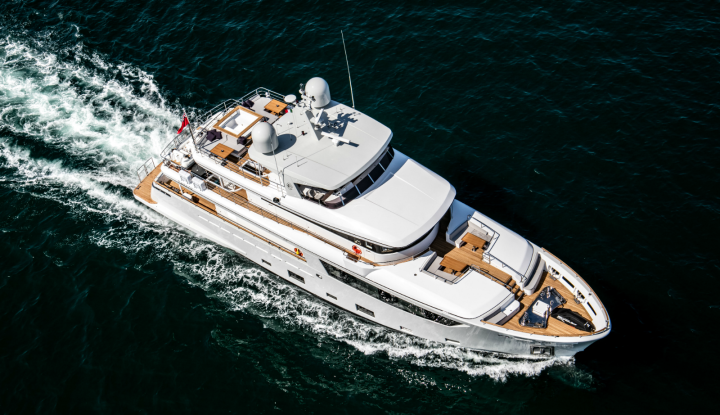If you’re going to check out superyachts, start with the very best. Boat International Media’s World Superyacht Awards 2017 winners were announced last weekend, at the 12th annual presentation event held in Florence, Italy. Comparable to the film industry’s Academy Awards, World Superyacht Awards winners take home Neptune trophies instead of Oscars.
Fifteen of the world’s biggest and best superyachts were selected for 17 awards from 60 nominees. Two vessels, Dilbar and Sybaris, won two awards each.
The following is a summary of the winners.
Displacement Motor Yacht of 3,000gt and Above and Motor Yacht of the Year
Dilbar

Dilbar won both the Displacement Motor Yacht of 3,000gt and Above and Motor Yacht of the Year Awards. Her 180-cubic-meter swimming pool and 30,000-kilowatt diesel electric power plant are the largest of any yacht. Plus, what other superyacht has two helipads?
Sailing Yacht of 40-meters and Above and Sailing Yacht of the Year
Sybaris

Sybaris won both the Sailing Yacht of 40-meters and Above and Sailing Yacht of the Year Awards. The 70-meter sailing vessel has deceptively low-profile styling, a luxurious interior, technical innovation, and highly rated sailing ability.
Voyager’s Award
Glaze

The 49-meter Glaze won the Voyager’s Award for the most daring and inspiring expedition by a superyacht. The cruise was along North West Australia’s rugged coastline, much of which is poorly or totally uncharted.
Displacement Motor Yachts of Between 1,500gt and 2,999gt
Cloudbreak

Cloudbreak is an explorer superyacht designed specifically to support mountaineering, hiking, and snow sports. Cloudbreak won the Displacement Motor Yachts of Between 1,500gt and 2,999gt Award.
Displacement Motor Yachts of Between 500gt and 1,499g Award
Joy

Joy impressed with her spacious decks, full height sliding glass panels, and active noise attenuation when underway. Joy won the Displacement Motor Yachts of Between 500gt and 1,499g Award.
Displacement Motor Yachts of Below 500gt — 43 meters and Above Award
La Passion

La Passion won the Displacement Motor Yachts of Below 500gt — 43 meters and Above Award because of her interior and exterior design, seaworthiness, and hull efficiency. This is the first yacht launched by SARP Yachts.
Displacement Motor Yachts of Below 500gt, 30-42.9 meters Award
Superyacht X

The Displacement Motor Yachts of Below 500gt, 30-42.9 meters Award went to X, an explorer yacht. X was praised by the judges for her power and range as well as loads of space on the main deck for toys.
Semi-Displacement or Planing Motor Yachts 50-meters and Above Award
Galactica Super Nova

Galactica Super Nova won the Semi-Displacement or Planing Motor Yachts 50meters and Above Award. She was judged for her performance, build quality, appearance, and facilities, including an outdoor cinema.
Semi-Displacement or Planing Motor Yachts of 40-49.9 meters Award
Amore Mio

The winner of the Semi-Displacement or Planing Motor Yachts of 40-49.9 meters Award, Amore Mio, won because of her versatility as a “summer house on the sea.”
Semi-Displacement or Planing Motor Yachts of 34-39.9 meters Award
Gipsy

Gipsy’s simple lines and optimized use of space appealed to the judges. Gipsy is lived in year round and won the Semi-Displacement or Planing Motor Yachts of 34-39.9 meters Award.
Semi-Displacement or Planing Motor Yachts of 30-33.9 meters Award
Botti

Botti’s 32.3-meter design, including a bimini-covered sundeck, a bathing platform, and a foredeck lounge with a cinema. Botti won the Semi-Displacement or Planning Motor Yachts of 30-33.9 meters Award.
Sailing Yacht of 30-39.9 meters Award
My Song

The sailing yacht My Song is a comfort-filled cruising yacht that also does well in races. For that combination, My Song won the Sailing Yacht of 30–39.9 meters Award.
Judge’s Special Award for Quality and Value Award
Narvalo

The explorer superyacht Narvalo won the Judge’s Special Award for Quality and Value Award. Narvalo scored on the basis of her spacious staterooms and living spaces as well as her long range, well-equipped and sturdy tender, and high level of autonomy.
Rebuilt Yachts Award
Legend

Legend started as a 34-year-old Russian tugboat. Little remains of that source vessel. Her hull was extended 3.6 meters and now includes a bathing platform, a 16-person swimming pool, and a helipad.
Refitted Yacht Award
Aquila

The 85.6-meter Aquila has no visible resemblance to her former self, which was the reason for her Refitted Yacht Award.



